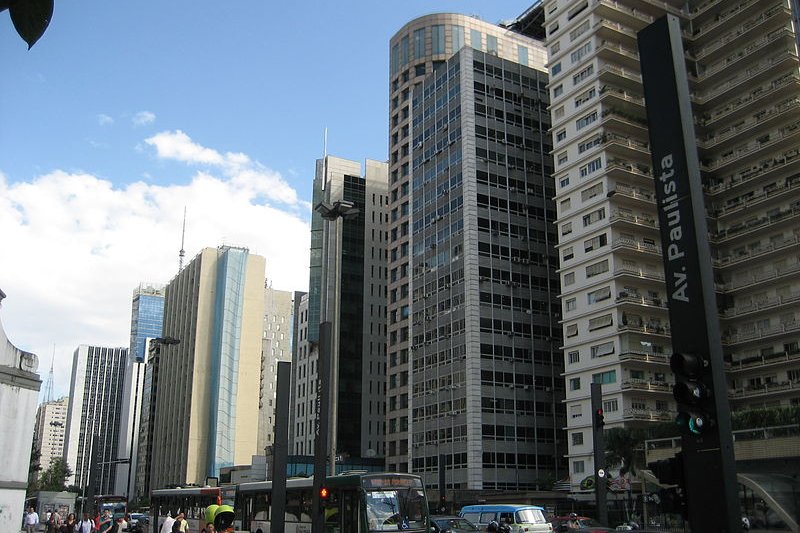 Avenida Paulista in downtown Sao Paulo, Brazil
Avenida Paulista in downtown Sao Paulo, BrazilSource: https://commons.wikimedia.org/wiki/File:Avenue_Paulista_(5187968494).jpg
Author: DearEdward

São Paulo is the biggest city in Brazil. It is also the biggest city in the southern hemisphere, the second biggest in the Americas, and the sixth biggest in the world. São Paulo has a population of 11 million people (2011 estimate) within a metropolitan area that has a population of 19.7 million, the fifth biggest metropolitan area in the world.
São Paulo covers 1,522.9 sq km (588 sq mi). It is located in Southeastern Brazil, and is also the capital of the State of São Paulo, which is the most populous state in the country. São Paulo is today a financial and commercial center for Latin America, and it also exerts a strong influence in regional culture and arts.
 Secretaria da Justiça, São Paulo
Secretaria da Justiça, São PauloSource: https://commons.wikimedia.org/wiki/File:Secretaria_da_Justi%C3%A7a,_SP_01.JPG
Author: Dornicke

São Paulo is approximately equidistance between Rio de Janeiro and Curitiba, the capital of Paraná State. It is on a plateau with an average height of 799 m (2,621 ft), and about 70 km (43 mi) from the Atlantic coast. The city experiences a humid subtropical climate. The Tropic of Capricorn passes north of São Paulo. The daily mean temperature ranges from 22.4°C (72.3°F) in January to 15.8°C (60.4°F) in July. The wettest months are January and February.
The history of São Paulo goes back to 1532, with the founding of the settlement of São Vicente, today a coastal city south of São Paulo. São Paulo itself was founded twenty-two years later, as the village of São Paulo dos Campos de Piratininga. Initially a mission station, São Paulo grew to become one of the richest cities in the country by the 18th century, due largely to prosperity from the coffee plantations in neighboring Santos.
 The Catedral Metropolitana de São Paulo, also called Sé
The Catedral Metropolitana de São Paulo, also called SéSource: https://commons.wikimedia.org/wiki/File:Catedral_Metropolitana_de_Sao_Paulo_3_Brasil.jpg
Author: Morio

The city of São Paulo grew in the 19th century, largely due to an influx of immigrants from Europe, particularly from Portugal, Italy, Spain and Germany. The years of prosperity finally came to an end in the early 20th century, caused by the decline in coffee prices. It forced the economy of São Paulo to diversify, to sugar cane and manufacturing. The city was able to cash in on an appetite for European products by manufacturing them domestically.
By the mid 20th century, São Paulo was the industrial hub of the country. However, even by the late 20th century, the Brazilian economy continued to chart huge trade deficits due to importation of European products. By then the city was facing competition from neighboring Brazilian cities, and it evolved from a manufacturing center to one based on service industries. Today it is home to most of the biggest banks, financial institutions and consumer services companies in Brazil.
Visiting São Paulo
The Guarulhos International Airport (GRU) is the main international airport serving São Paulo. There are shuttle buses from the airport to downtown (Praça da República, to the Paulista/Jardins neighborhood, and other places. The fare is R$28. Alternatively, if you take the regular city bus, it will cost only R$3.80. Taxis are available for between R$75 to R$100, depending on your exact destination. Mercado Municipal Paulistano, São Paulo
Mercado Municipal Paulistano, São PauloSource: https://commons.wikimedia.org/wiki/File:Mercado_Municipal_Paulistano,_interior.JPG
Author: Dornicke

Exploring São Paulo
As a tourist, your best bet is to take the Metrô subway system. Get the Bilhete Único smartcard, which can be used to pay the fares for the buses, subways and trains. Each billing on the card allows you to travel for up to four trips on the system, with free transfers between the subway and buses, for up to 2 hours. The cards are available at the subway stations. You can top them at most newspaper stands.The Metrô presently has five lines of which four are fully operational and one is partially under construction. Without the Bilhete Único smart card, you can buy a single-trip ticket for R$2.90. Getting the smartcard won't get you a discount, rather, just save you the hassle of looking for the vending machine each time you travel.
Places of Interest in São Paulo, Brazil
- Banespa Tower
- Basilica of Our Lady of Mount Carmel (Santuário Basílica de Nossa Senhora do Monte Carmelo)
- Biblioteca Mário de Andrade
- Edificio Altino Arantes
- Edifío Copan
- Edifío Itália
- Igreja da Boa Morte
- Ladeira da Memória
- Largo de São Bento
- Museu Casa de Anchieta
- Museu da Língua Portuguesa
- Museu de Arte de São Paulo
- Museu de Arte Sacra
- Museu Paulista (Museu do Ipiranga)
- Praça da Sé
- Solar da Marquesa de Santos
 Latest updates on Penang Travel Tips
Latest updates on Penang Travel Tips

Copyright © 2003-2025 Timothy Tye. All Rights Reserved.

 Go Back
Go Back